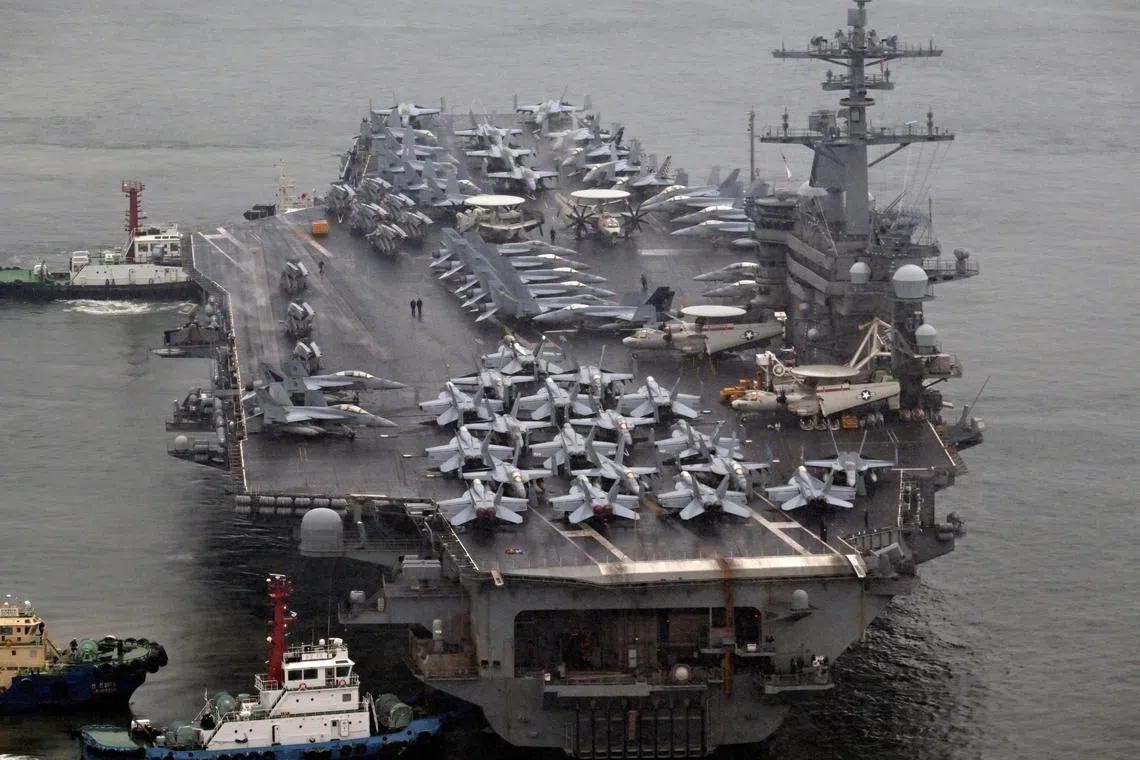US to send more warships, fighter jets to Middle East to bolster defence of Israel
Sign up now: Get ST's newsletters delivered to your inbox

The US is relieving the aircraft carrier Theodore Roosevelt with the Abraham Lincoln, as it bolsters its presence in the Middle East.
PHOTO: REUTERS
Follow topic:
WASHINGTON – The US military will deploy additional fighter jets and navy warships to the Middle East, the Pentagon said on Aug 2, as Washington seeks to bolster defences following threats to Israel from Iran and its allies Hamas and Hezbollah.
The United States is braced for Iran to make good on its vow to respond to the killing of Hamas leader Ismail Haniyeh on July 31 in Tehran
US Defence Secretary Lloyd Austin has approved sending an additional squadron of F-22 fighter jets, an unspecified number of additional navy cruisers and destroyers capable of intercepting ballistic missiles and, if needed, more land-based ballistic-missile defence systems.
To maintain the presence of an aircraft carrier and its accompanying warships in the Middle East, Mr Austin also directed the Abraham Lincoln, now in the eastern Pacific, to relieve the Theodore Roosevelt in the next few weeks, when the latter aircraft carrier is scheduled to return to the US.
Some ships already in the western Mediterranean Sea will move east, closer to the coast of Israel, to provide more security, a senior Pentagon official said.
“Austin has ordered adjustments to US military posture designed to improve US force protection, to increase support for the defence of Israel, and to ensure the United States is prepared to respond to various contingencies,” the Pentagon said in a statement.
Meanwhile, an anxious calm hung over Israel as the country braced itself for how Iran would retaliate.
Local officials in Israel have urged residents to prepare food and water in fortified safe rooms.
Paramedics conducted an emergency drill modeling a response to a full-scale war with Iran and its proxies. Medical centres in northern Israel prepared for the possibility that they might need to move patients into protected underground wards.
Iran’s Revolutionary Guards said on Aug 3 that its response would be “severe and at an appropriate time, place and manner”
The Revolutionary Guards also accused the “criminal US government” of supporting the assassination.

People gather to watch the sunset in Tel Aviv as an anxious calm hung over Israel as the country braced itself for how Iran would retaliate.
PHOTO: REUTERS
The US military also intensified deployments prior to April 13, when Iran launched an attack on Israeli territory with drones and missiles. At the time, Israel successfully knocked down almost all of the roughly 300 drones and missiles with the help of the US and other allies.
Still, the threat from Hezbollah in Lebanon could present unique challenges to any efforts by the US to intercept drones and missiles, given the group’s vast arsenal and immediate proximity to Israel.
Iran said on Aug 3 that it expects Hezbollah to hit deeper inside Israel and no longer confine strikes to military targets after Israel killed the group’s military chief Fuad Shukr
Hezbollah has been exchanging near-daily fire with Israeli forces, saying it is targeting military positions over the border to support its ally, the Palestinian militant group Hamas, which is waging war with Israel in the Gaza Strip.
But a strike claimed by Israel in an overcrowded residential area of South Beirut changed the calculus, Iran’s mission to the United Nations said.
“We expect... Hezbollah to choose more targets and (strike) deeper in its response,” said the mission, quoted by the official IRNA news agency.
“Secondly, that it will not limit its response to military targets.”
Haniyeh’s death was one in a series of killings of senior Hamas figures as the war in Gaza between Hamas and Israel nears its 11th month and concern grows that the conflict is spreading across the Middle East.
Israeli Defence Minister Yoav Gallant said in a statement on Aug 2 that he spoke with his American and British counterparts, Mr Austin and British Defence Secretary John Healey, and provided “a situational assessment in the light of recent security developments”.
The Pentagon said Mr Austin, in the phone conversation with Mr Gallant, expressed concerns about the dangers of escalation and said that all countries in the region would benefit from defusing tensions.
Mr Healey said in a statement: “Meeting with senior leaders across the region, including today in Israel, we urged all sides to show restraint and dial down the tension at this critical moment.
“We also need to see an immediate ceasefire, hostages released and aid getting in, in sufficient quantity, to alleviate the suffering in Gaza.”
US President Joe Biden, in a phone call on Aug 1 with Israeli Prime Minister Benjamin Netanyahu, had discussed new US defensive military deployments
As a result of the heightened tension in the Middle East, OpsGroup, a membership-based organisation that shares flight risk information, advised in a bulletin for traffic between Asia and Europe to avoid Iranian and Iraqi airspace, reported Reuters.
Singapore Airlines (SIA) and budget carrier Scoot had stopped using Iranian airspace
Flights that may be affected include all SIA flights between Singapore and 14 locations – namely Amsterdam, Brussels, Copenhagen, Frankfurt, Istanbul, London, New York (JFK), New York (Newark), Manchester, Milan, Munich, Paris, Rome and Zurich – as well as all Scoot flights between Singapore and Athens. REUTERS, BLOOMBERG, NYTIMES

